Discover the transformative role of horses and chariots in ancient Egyptian warfare, revolutionizing military strategies and enhancing cultural and royal symbolism. Explore how these advancements elevated social status, influenced art, and left an enduring mark on Egypt's legacy.
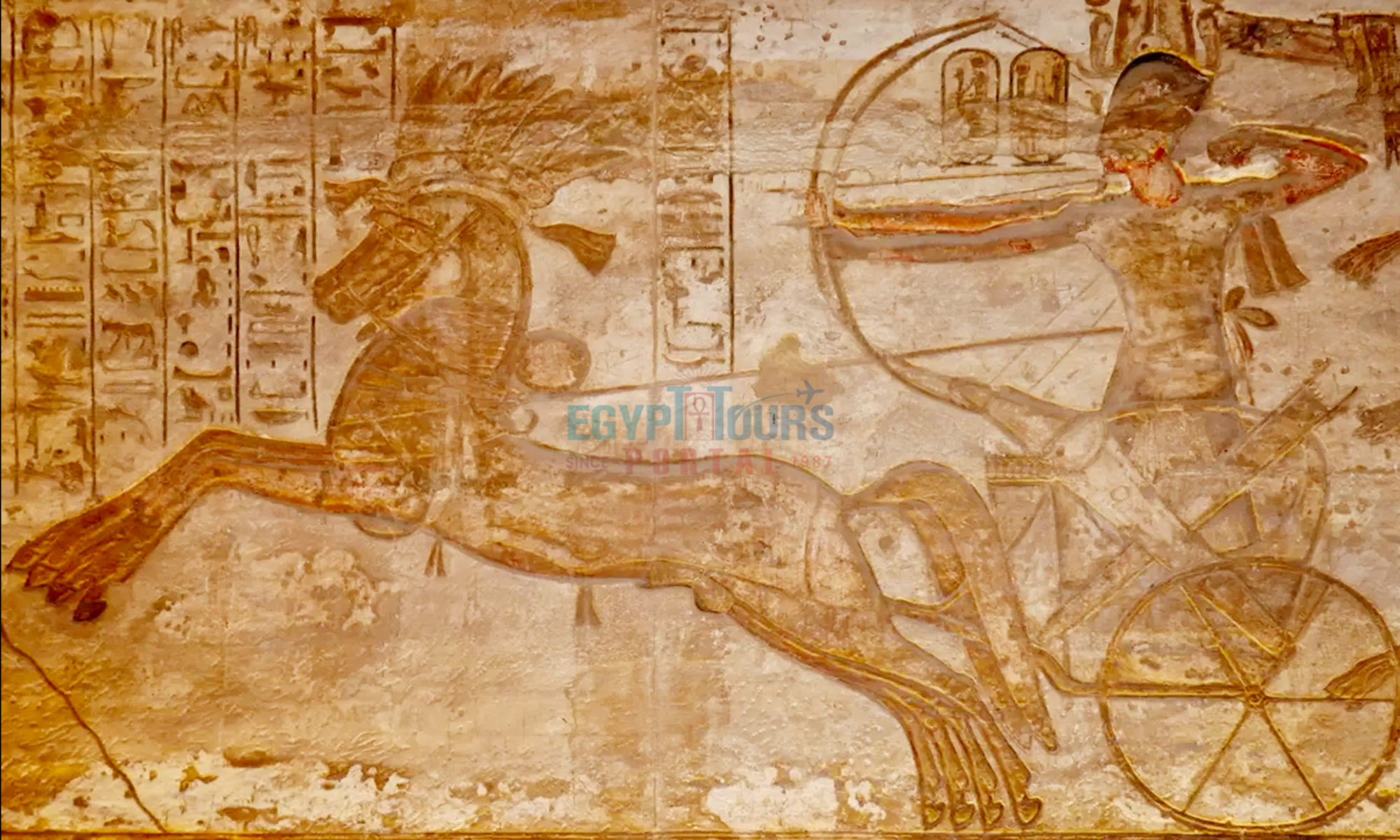
Ancient Egyptian Chariots and Horses have spanned over three millennia and made few innovations and a profound impact on warfare, trade, and royal iconography. Introduced during the tumultuous Second Intermediate Period (c. 1650–1550 BCE), when foreign Hyksos rulers brought new ideas and technologies to the Nile River Valley, horses quickly captured the imagination of Egyptian leaders and artisans.
Their swift integration into the royal stables and military ranks sparked an era of engineering creativity, culminating in chariots that were lighter, faster, and more maneuverable than any previously known in the ancient Near East. Beyond their tactical advantages on the battlefield, horses and chariots came to symbolize prestige, power, and the refined sophistication of the Egyptian elite, leaving an indelible mark on the kingdom’s art, architecture, and cultural identity.
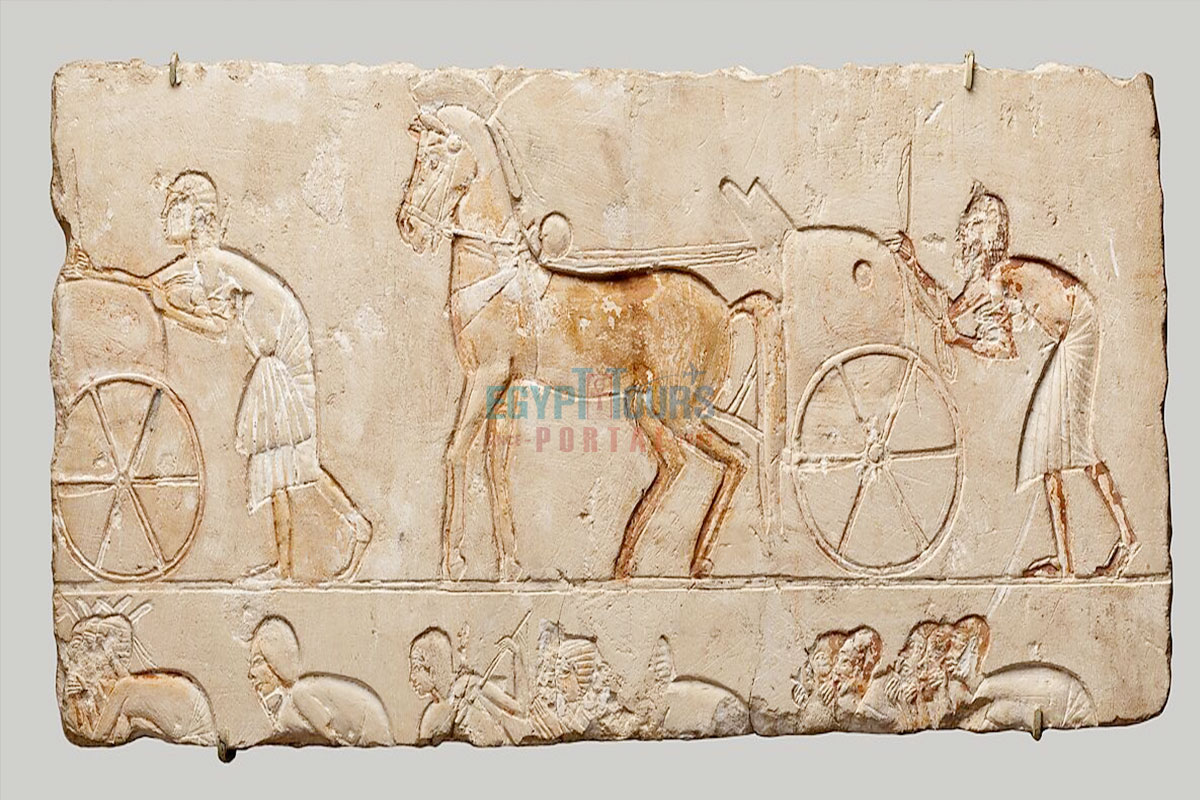
Horses first made their way into Egypt during the Second Intermediate Period (c. 1650–1550 BCE), primarily through the influence of the Hyksos, a foreign dynasty of Levantine origin who controlled Lower Egypt. Archaeological excavations at Tell el-Dab’a (Avaris), the Hyksos capital, have uncovered horse remains and related artifacts dating to the mid-17th century BCE, indicating that these animals were introduced as part of the Hyksos cultural package. The earliest written mention of horses in Egypt appears on the stela of Kamose (c. 1550 BCE), reflecting how rapidly Egyptians recognized the strategic value of these new assets.
Throughout the New Kingdom Of Ancient Egypt (c. 1550–1070 BCE), Egypt established royal stables and refined breeding programs to produce horses suited to the Nile Valley’s unique environment. By the reign of Thutmose III (1479–1425 BCE), horses had become a regular feature in the Egyptian army and ceremonial events. Improved stable management, selective breeding, and a steady exchange of knowledge with neighboring cultures ensured that Egyptian horses were strong, swift, and better adapted for pulling chariots and participating in hunting expeditions.
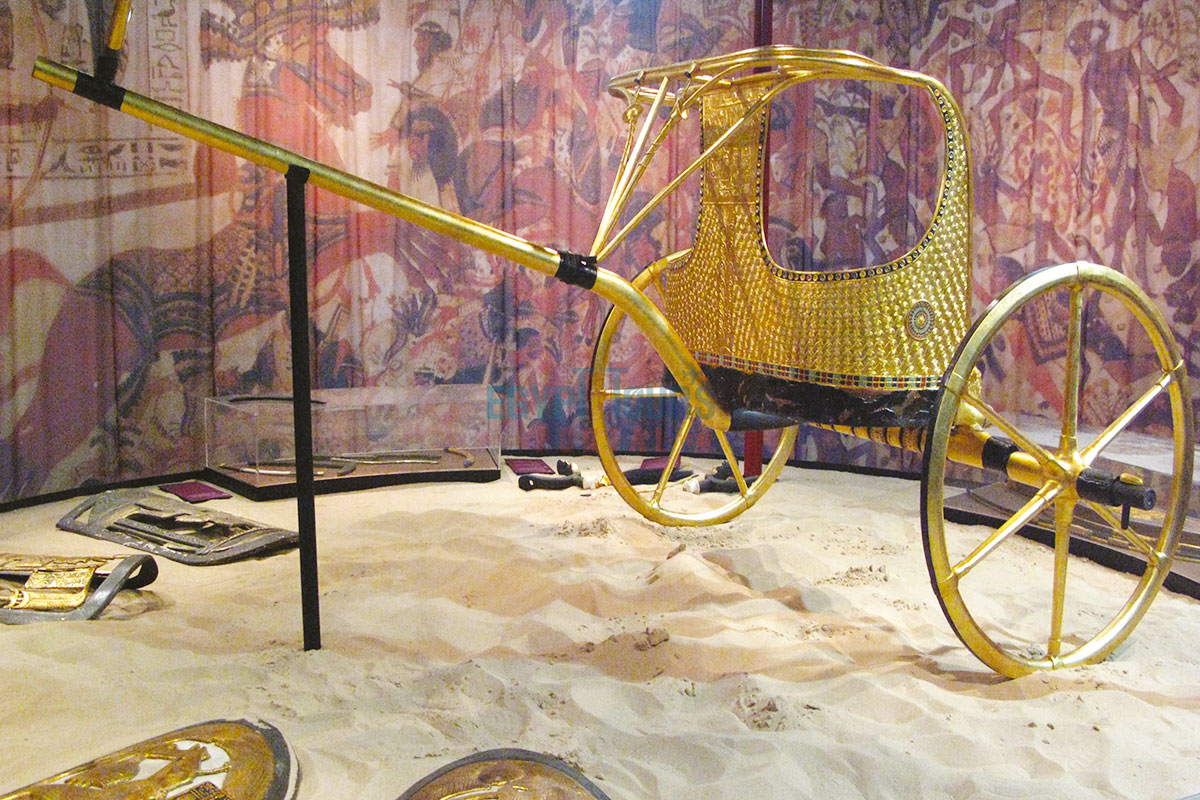
The horse’s introduction directly influenced the development of the Egyptian chariot, which first appeared in the late Second Intermediate Period and became standard by the early 18th Dynasty (c. 1550 BCE). Early designs drew heavily from Asiatic influences, as suggested by the Semitic terminology used to describe chariot parts. Around 1500 BCE, the Egyptians invented the yoke saddle, which distributed the load evenly across a horse’s back, reducing strain and improving the animal’s performance.
By the time of Amenhotep II (1427–1400 BCE), Egyptian chariots featured robust yet lightweight frames, metal-reinforced axles, and spoke-wheeled construction. The shift from four-spoked to six-spoked wheels by the late 18th and early 19th Dynasties (c. 1300 BCE onward) further reduced weight and improved stability, making Egyptian chariots among the most agile in the ancient Near East.
Chariots are depicted extensively in the Ancient Egyptian art of the New Kingdom, including the reigns of Hatshepsut (1479–1458 BCE), Thutmose III, Amenhotep II, and Ramses II (1279–1213 BCE). Tomb paintings in the Theban necropolis, such as in the tomb of Nebamun (c. 1350 BCE), show chariots during banquets and hunting scenes. On temple walls at Karnak, Luxor, and Abydos, reliefs often portray the pharaoh alone in his chariot, bow drawn, firing arrows into enemy ranks or hunting lions—a visual testament to the chariot’s symbolic importance as a vehicle of royal power and divine protection.
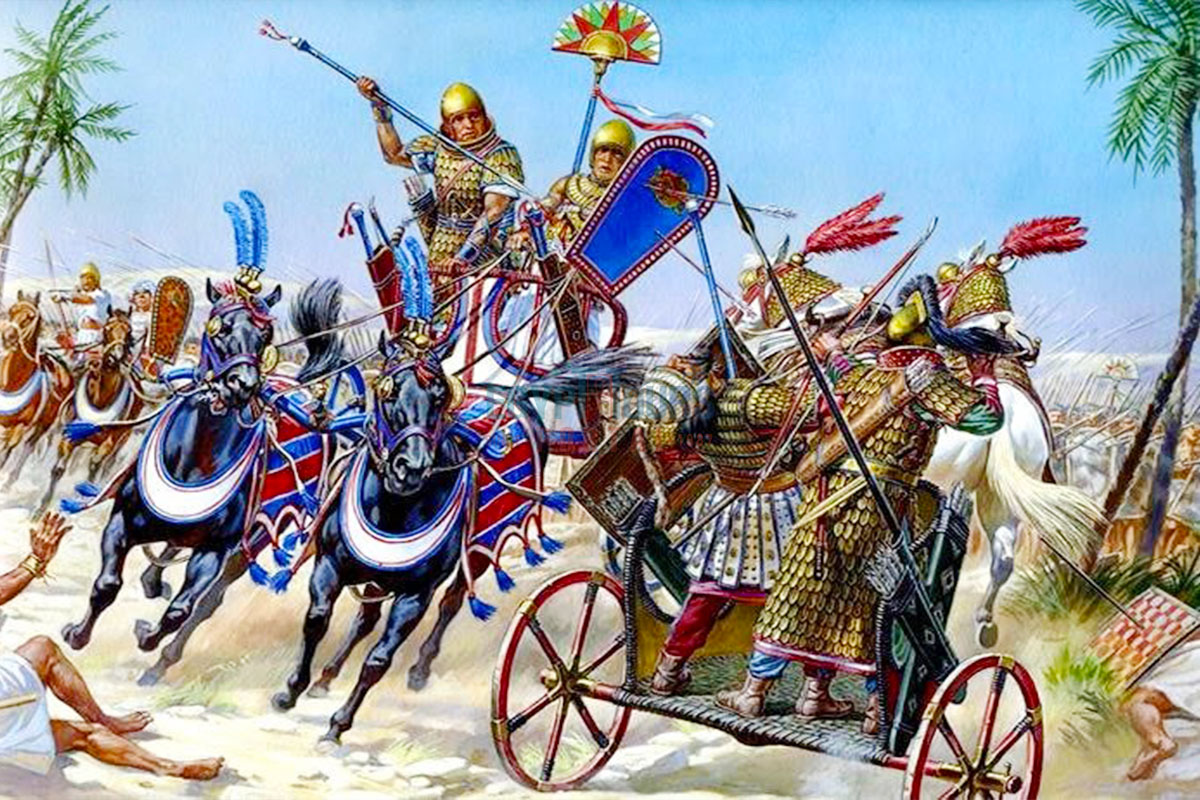
By the early New Kingdom, the chariot had transformed Egyptian warfare. Able to travel swiftly over flat terrain, chariots offered a stable firing platform for archers wielding composite bows. Their speed and maneuverability allowed commanders to outflank slower infantry units, disrupt enemy formations, and rapidly shift positions on the battlefield. This innovation contributed to Egypt’s success in campaigns stretching into Canaan, Syria, and Nubia, under kings like Thutmose III and Amenhotep II.
A prime example of chariot warfare is the Battle of Kadesh (c. 1274 BCE), fought between Ramses II of Egypt and Muwatalli II of the Hittites. Though the battle ended inconclusively, it featured what is likely the largest chariot engagement in history, involving thousands of vehicles on both sides. Earlier campaigns by Thutmose III also illustrated chariots' strategic advantage, enabling him to subjugate territories far from Egypt’s heartland and secure vital trade routes and tribute.
Explore the history and the role the chariots played in the battles of Ancient Egypt.
Read More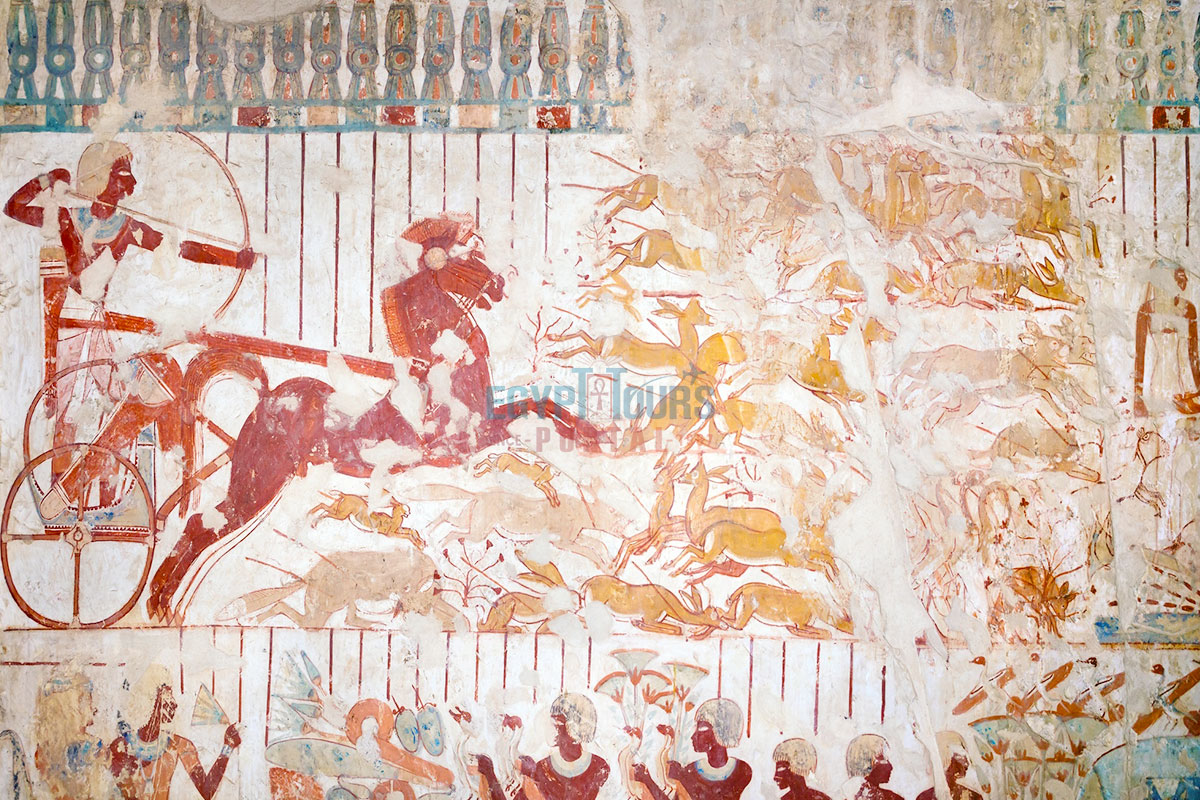
Horses and chariots were expensive to maintain, reflecting an owner’s wealth and status. Elite warriors known as the maryannu—an aristocratic chariot corps—emerged, mirroring similar classes across the Near East. High-ranking officials, nobles, and even the king’s inner circle often held positions related to chariotry, and the vehicles themselves became closely linked to royal identity. By the 19th Dynasty (1292–1189 BCE), inscriptions attest to the careful naming of royal horses, sometimes with theophoric elements, underscoring the prestige and reverence afforded to these creatures.
While not directly deified, horses and chariots frequently appeared in religious narratives and iconography. For instance, the emphasis placed by pharaohs like Amenhotep II on their skill in driving and archery from a chariot highlighted their divine right to rule. Textual sources, including temple inscriptions and monumental reliefs, sometimes depicted gods overseeing or blessing the chariot and its horses, bridging the secular and spiritual worlds. By the time of Ramses II, the chariot had been fully integrated into the symbolic language of kingship and cosmic order.
Explore magnificent details about the beliefs and dogma of the religion of the ancient Egyptians.
Read More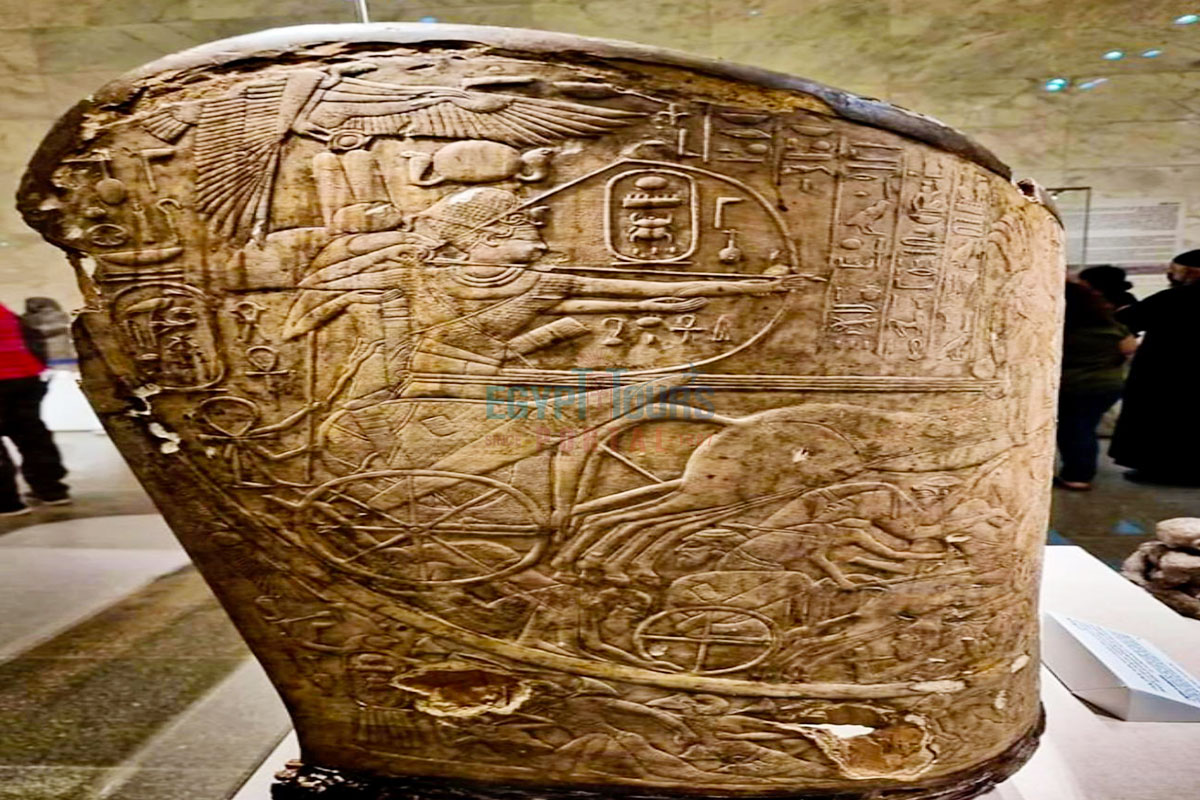
Among the most illuminating archaeological finds are the six chariots discovered in the tomb of Tutankhamun (c. 1332–1323 BCE) by Howard Carter in 1922. These chariots, painstakingly constructed with woods imported from various regions and adorned with gilding, paint, and leather fittings, confirm the luxurious and technologically advanced nature of elite Egyptian chariotry. Horse skeletons found in other high-status burials and stable areas, such as those at Pi-Ramesses (the capital under Ramses II), provide further insight into breeding, care, and the dietary regimes of these prized animals.
Modern scholarship continues to debate various aspects of Egyptian chariotry. Questions linger about how often chariots were employed in actual combat versus ceremonial or symbolic roles, the extent to which metal fittings improved performance, and the existence and purpose of early horse gear like proto-horseshoes or protective coverings.
While no conclusive evidence of functional horseshoes has been found in ancient Egypt, some scholars speculate about symbolic or decorative uses, drawing on folklore and parallels with neighboring cultures. New radiocarbon dating methods, stable isotope analyses of horse remains, and fresh textual interpretations ensure that our understanding of Egyptian horses and chariots will continue to evolve.
By the height of the New Kingdom (c. 1550–1070 BCE), horses and chariots had evolved from foreign novelties into central pillars of Egyptian society. They reshaped military strategy, enabling swift campaigns and bolstering the pharaoh’s aura of invincibility. They adorned temple walls, telling stories of regal hunts and heroic battles that underscored the divinity of kingship and the cosmic order.
Even as cavalry gradually supplanted chariots in warfare, the memory of their grandeur lingered in religious imagery, royal propaganda, and the myths that connected human rulers with divine realms. Today, the horses’ skeletal remains and the chariots found in tombs like that of Tutankhamun provide invaluable archaeological evidence that allows us to reconstruct a vivid tableau of innovation and splendor.
In their legacy, we find a testament to Egypt’s adaptability, its boundless artistry, and the enduring fascination of a civilization that harnessed both nature and invention to shape its destiny. Be one of the lucky few and ride your way across all the heavenly attractions and monuments of Egypt with our magical Egypt Vacations and Nile River Cruises.
Private 4 Days Cairo Tour Packages 4 days Cairo Egypt tour package will offer a bles...
Tour Location: Cairo – Giza...
Stunning 5 Days Cairo and Alexandria Tour Package 5 days Cairo and Alexandria tour p...
Tour Location: Cairo/Giza/Alexandria...
Exceptional 6 Days Cairo, Luxor & Aswan Tour Package 6 days Cairo, Luxor & A...
Tour Location: Cairo/Giza/Aswan/Luxor...
Amazing 7 Days Cairo and Hurghada Holiday 7 Days Cairo & Hurghada holiday will e...
Tour Location: Cairo – Giza – Hurgh...
Horses Were Introduced During the Second Intermediate Period (Around 1650–1550 Bce), Likely Through the Hyksos. Initially Rare and Prestigious, They Were Gradually Integrated Into Egyptian Society and Eventually Became Central to Military and Ceremonial Life.
With Horses Came Advancements in Chariot Technology. Egyptians Refined Asiatic Designs Into Lighter, More Maneuverable Vehicles. Innovations Such as the Yoke Saddle (Around 1500 Bce) and Six-spoked Wheels Enhanced Speed, Stability, and Efficiency, Making Egyptian Chariots Among the Most Agile in the Ancient Near East.
In Their Early Adoption, Chariots Played a Crucial Role in Warfare, Providing Swift Mobility, a Stable Firing Platform for Archers, and Significant Psychological Impact. High-profile Battles, Like the Battle of Kadesh (C. 1274 Bce) Under Ramses Ii, Showcased the Strategic Value of Chariots in Large-scale Military Engagements.
Yes. Beyond Combat, Chariots Symbolized Status, Authority, and Divine Favor. Pharaohs Were Often Depicted Driving Chariots During Hunts, Religious Ceremonies, and State Processions. These Images Underscored Royal Power, Linking the Ruler’s Skill in Handling Chariots With Cosmic Order and Divine Sanction.
Archaeological Finds Include the Six Chariots From Tutankhamun’s Tomb, Which Offer Detailed Insights Into Their Construction and Decoration. Tomb Paintings, Temple Reliefs, Inscriptions, and Occasional Horse Remains Also Provide Invaluable Information About Chariot Usage, Royal Stables, and Charioteers’ Social Status.
As Cavalry Emerged Around 1000 Bce, Chariotry’s Prominence in Warfare Gradually Declined. Though Less Essential in Battle, Chariots Remained Significant in Hunting Expeditions, Ceremonial Events, and Iconography, Retaining Their Symbolic Value Well Into Later Periods.
Maintaining Horses and Chariots Was Costly, Placing Them Largely in the Hands of the Elite. Chariot Warriors (Maryannu) Formed a New Aristocratic Class, and Gaining a Position in the Chariot Corps Could Elevate an Individual’s Status. Royal Breeding Programs Ensured a Steady Supply of Well-trained, High-quality Horses for These Elites.
Horses Received Exceptional Care, With Dedicated Stablemen and Veterinarians Managing Their Well-being. Pharaohs Sometimes Named Their Favorite Horses and Recorded Their Loyalty in Inscriptions. The Careful Maintenance and High Regard for Horses Reflected Both Their Practical and Symbolic Importance.
Training Began With Conditioning Horses to Accept Harnesses, Chariots, and Commands. Charioteers Learned Specialized Skills Such as Shooting Accurately on the Move, Controlling Pairs of Horses at Full Gallop, and Coordinating With Infantry. By the Reign of Amenhotep Ii (1427–1400 Bce), These Skills Were Well-honed, Contributing to Egypt’s Military Successes.
Though Egypt’s Climate Differed From the Horses’ Original Habitats, Selective Breeding and Improved Stable Management Helped Them Adapt. Breeders Focused on Producing Durable, Fast, and Resilient Animals Suitable for Warfare and Hunting. The Royal Stables Ensured Proper Feeding, Grooming, Veterinary Care, and the Use of Saddles and Harnesses That Minimized Stress and Injury.
The entire country of Egypt deserve to be explored with its every heavenly detail but there are places that must be seen before any other such as the breathtaking Hurghada's red sea, The wonders of Cairo the pyramids of Giza, the great sphinx, the Egyptian Museum, Khan El Khalili Bazaar, the wonders of Luxor like Valley of the Kings, Karnak & Hatshepsut temple and the wonders of Aswan such as Abu Simbel temples, Philea temple, Unfinished obelisk and The Wonders of Alexandria like Qaitbat Citadel, Pompey's Pillar and Alexandria Library. Read more about the best places to visit in Egypt.
If you want to apply for a Visa On Arrival that lasts for 30 days then you should be one of the eligible countries, have a valid passport with at least 6 months remaining and pay 25$ USD in cash, as for the E-Visa for 30 day you should have a valid passport for at least 8 months, complete the online application, pay the e-visa fee then print the e-visa to later be presented to the airport border guard. You could also be one of the lucky ones who can obtain a free visa for 90 days. Read more about Egypt travel visa.
Egypt has a variety of delicious cuisines but we recommend “Ful & Ta’meya (Fava Beans and Falafel)”, Mulukhiya, “Koshary”, a traditional Egyptian pasta dish, and Kebab & Kofta, the Egyptian traditional meat dish.
The best time to travel to Egypt is during the winter from September to April as the climate becomes a little tropical accompanied by a magical atmosphere of warm weather with a winter breeze. You will be notified in the week of your trip if the Climate is unsafe and if any changes have been made.
You should pack everything you could ever need in a small bag so you could move easily between your destinations.
We have been creating the finest vacations for more than 20 years around the most majestic destinations in Egypt. Our staff consists of the best operators, guides and drivers who dedicate all of their time & effort to make you have the perfect vacation. All of our tours are customized by Travel, Financial & Time consultants to fit your every possible need during your vacation. It doesn't go without saying that your safety and comfort are our main priority and all of our resources will be directed to provide the finest atmosphere until you return home.
You will feel safe in Egypt as the current atmosphere of the country is quite peaceful after the government took powerful measures like restructuring the entire tourist police to include all the important and tourist attractions in Egypt. Read more about is it safe to travel to Egypt.
Wear whatever feels right and comfortable. It is advised to wear something light and comfortable footwear like a closed-toe shoe to sustain the terrain of Egypt. Put on sun block during your time in Egypt in the summer to protect yourself from the sun.
The best activity is by far boarding a Nile Cruise between Luxor and Aswan or Vise Versa. Witness the beauty of Egypt from a hot balloon or a plane and try all the delicious Egyptian cuisines and drinks plus shopping in old Cairo. Explore the allure and wonders of the red sea in the magical city resorts of Egypt like Hurghada and many more by diving and snorkeling in the marine life or Hurghada. Behold the mesmerizing western desert by a safari trip under the heavenly Egyptian skies.
There are a lot of public holidays in Egypt too many to count either religious or nation, the most important festivals are the holy month of Ramadan which ends with Eid Al Fitr, Christmas and new years eve. Read more about festivals & publich holidays in Egypt.
Egypt is considered to be one of the most liberal Islamic countries but it has become a little bit conservative in the last couple of decades so it is advised to avoid showing your chest, shoulders or legs below the knees.
Arabic is the official language and Most Egyptians, who live in the cities, speak or understand English or at least some English words or phrases. Fewer Egyptians can speak French, Italian, Spanish, and German. Professional tour guides, who work in the tourism sector, are equipped to handle visitors who cannot speak Arabic and they will speak enough English and other languages to fulfill the needs of all our clients.
The fastest way is a car, of course, a taxi. If you are in Cairo ride a white taxi to move faster or you could board the fastest way of transportation in Egypt metro if the roads are in rush hour.
The temperature in Egypt ranges from 37c to 14 c. Summer in Egypt is somehow hot but sometimes it becomes cold at night and winter is cool and mild. The average of low temperatures vary from 9.5 °C in the wintertime to 23 °C in the summertime and the average high temperatures vary from 17 °C in the wintertime to 32 °C in the summertime. The temperature is moderate all along the coasts.
It is the home of everything a traveler might be looking for from amazing historical sites dating to more than 4000 years to enchanting city resorts & beaches. You will live the vacation you deserve as Egypt has everything you could possibly imagine.









